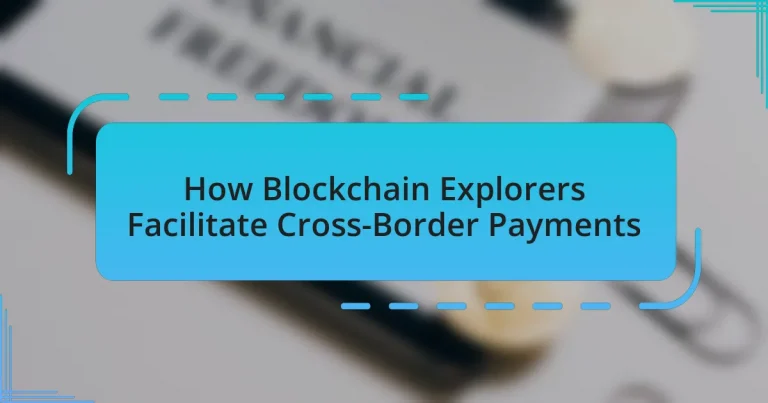Blockchain explorers are essential tools that enable users to view and analyze transactions on blockchain networks, playing a significant role in facilitating cross-border payments. They provide transparency and traceability, allowing users to track payment statuses in real-time, verify transaction details, and ensure successful fund transfers across borders. The article discusses how blockchain explorers enhance transaction efficiency, reduce costs, and improve user trust by offering detailed transaction data and minimizing the need for intermediaries. Additionally, it explores the future trends of blockchain explorers, including their integration with emerging technologies and the impact of regulatory changes on their functionality.
What are Blockchain Explorers and Their Role in Cross-Border Payments?
Blockchain explorers are tools that allow users to view and analyze transactions on a blockchain network. They play a crucial role in cross-border payments by providing transparency and traceability of transactions, which enhances trust among parties involved in international transfers. For instance, blockchain explorers enable users to track the status of their payments in real-time, verify transaction details, and ensure that funds have been successfully transferred across borders. This transparency is vital in reducing fraud and disputes, as all transaction data is publicly accessible and immutable, thus fostering confidence in the cross-border payment process.
How do Blockchain Explorers function in the context of cross-border payments?
Blockchain explorers function as tools that allow users to view and track transactions on a blockchain, which is crucial for cross-border payments. They provide real-time access to transaction details, including sender and receiver addresses, transaction amounts, and confirmation statuses. This transparency helps users verify the status of their cross-border transactions, ensuring that funds are transferred accurately and efficiently. For example, in the Bitcoin network, explorers like Blockchair or Blockchain.com enable users to input transaction IDs to retrieve detailed information, thereby enhancing trust and accountability in international money transfers.
What data do Blockchain Explorers provide for cross-border transactions?
Blockchain explorers provide transaction data such as transaction IDs, timestamps, sender and receiver addresses, transaction amounts, and confirmation statuses for cross-border transactions. This data allows users to track the flow of funds across different jurisdictions, verify transaction authenticity, and ensure compliance with regulatory requirements. For example, a blockchain explorer can show the exact time a transaction was initiated and how many confirmations it has received, which is crucial for assessing the reliability and speed of cross-border payments.
How do Blockchain Explorers ensure transaction transparency and security?
Blockchain explorers ensure transaction transparency and security by providing real-time access to the blockchain’s public ledger, which records all transactions in an immutable format. This transparency allows users to verify transaction details such as amounts, sender and receiver addresses, and timestamps, thereby fostering trust among participants. Additionally, the decentralized nature of blockchain technology means that no single entity controls the data, reducing the risk of fraud and manipulation. The cryptographic algorithms used in blockchain also enhance security by ensuring that transactions are securely encrypted and linked to previous transactions, making it nearly impossible to alter past records without consensus from the network.
Why are Blockchain Explorers essential for cross-border payments?
Blockchain explorers are essential for cross-border payments because they provide transparency and traceability of transactions on the blockchain. By allowing users to view transaction details, including sender and receiver addresses, amounts, and timestamps, blockchain explorers enhance trust in the payment process. This transparency is crucial in cross-border transactions, where parties may not have established relationships. Furthermore, the ability to track transactions in real-time helps to reduce fraud and errors, ensuring that payments are processed accurately and efficiently. According to a report by the World Bank, increased transparency in financial transactions can lead to a reduction in costs and time associated with cross-border payments, making blockchain explorers a vital tool in this context.
What challenges in cross-border payments do Blockchain Explorers address?
Blockchain Explorers address challenges in cross-border payments such as transparency, transaction speed, and cost efficiency. By providing real-time tracking of transactions on the blockchain, these tools enhance transparency, allowing users to verify the status and authenticity of payments. Additionally, Blockchain Explorers facilitate faster transaction confirmations compared to traditional banking systems, which often involve lengthy processing times. They also contribute to reducing costs associated with cross-border transactions by minimizing intermediaries and associated fees, making the payment process more economical for users.
How do Blockchain Explorers enhance user trust in cross-border transactions?
Blockchain explorers enhance user trust in cross-border transactions by providing transparent, real-time access to transaction data. Users can independently verify transaction details such as amounts, timestamps, and sender/receiver addresses, which fosters accountability. For instance, a study by the Cambridge Centre for Alternative Finance found that transparency in blockchain transactions significantly reduces fraud risk, thereby increasing user confidence. This verifiability allows users to track their transactions across borders, ensuring that funds are transferred as intended, which is crucial in a global financial landscape.
How do Blockchain Explorers Improve Efficiency in Cross-Border Payments?
Blockchain explorers enhance efficiency in cross-border payments by providing real-time visibility into transaction statuses and blockchain data. They allow users to track transactions from initiation to confirmation, reducing uncertainty and improving transparency. This visibility helps in identifying potential issues quickly, thereby minimizing delays. Additionally, blockchain explorers facilitate the verification of transaction authenticity and ensure compliance with regulatory requirements, which streamlines the payment process. By offering detailed insights into transaction history and network performance, they contribute to faster and more reliable cross-border payment systems.
What specific features of Blockchain Explorers contribute to payment efficiency?
Blockchain explorers enhance payment efficiency through real-time transaction tracking, transparency, and user-friendly interfaces. Real-time tracking allows users to monitor the status of transactions instantly, reducing uncertainty and enabling quicker decision-making. Transparency ensures that all transaction details are publicly accessible, which fosters trust among users and minimizes the risk of fraud. User-friendly interfaces simplify the navigation and understanding of complex blockchain data, making it easier for users to initiate and confirm payments. These features collectively streamline the payment process, making cross-border transactions faster and more reliable.
How do real-time transaction tracking and reporting work?
Real-time transaction tracking and reporting work by utilizing blockchain technology to provide immediate visibility into transaction data as it occurs. Each transaction is recorded on a decentralized ledger, allowing participants to access and verify transaction details in real-time. This transparency is facilitated by blockchain explorers, which are tools that allow users to view transaction histories, confirmations, and statuses instantly. For example, Bitcoin transactions can be tracked on platforms like Blockchair or Blockchain.com, where users can see transaction IDs, amounts, and timestamps, ensuring accountability and reducing fraud risk. The decentralized nature of blockchain ensures that this information is immutable and accessible to all network participants, enhancing trust in cross-border payments.
What role does automation play in streamlining cross-border payments?
Automation significantly enhances the efficiency of cross-border payments by reducing processing times and minimizing human errors. Automated systems enable real-time transaction processing, which accelerates the transfer of funds across borders. For instance, blockchain technology facilitates automated smart contracts that execute transactions without manual intervention, ensuring faster settlement times compared to traditional banking methods. According to a report by McKinsey, automation in payment systems can reduce transaction costs by up to 30%, demonstrating its effectiveness in streamlining cross-border payment processes.
How do Blockchain Explorers reduce costs associated with cross-border payments?
Blockchain explorers reduce costs associated with cross-border payments by providing transparent and real-time access to transaction data, which minimizes the need for intermediaries. By allowing users to track transactions directly on the blockchain, explorers eliminate the fees typically charged by banks and payment processors for currency conversion and transaction verification. For instance, a study by the World Bank indicated that traditional cross-border payment methods can incur fees as high as 7% of the transaction amount, whereas blockchain transactions can reduce these costs to less than 1%. This significant reduction in fees is achieved through the decentralized nature of blockchain technology, which streamlines the payment process and enhances efficiency.
What are the cost-saving mechanisms employed by Blockchain Explorers?
Blockchain Explorers employ several cost-saving mechanisms, primarily through transaction transparency, reduced intermediaries, and lower fees. By providing real-time access to transaction data, Blockchain Explorers enhance transparency, which minimizes the risk of fraud and reduces costs associated with dispute resolution. Additionally, they facilitate direct peer-to-peer transactions, significantly lowering the need for intermediaries such as banks or payment processors, which typically charge high fees. Furthermore, the use of blockchain technology allows for lower transaction fees compared to traditional financial systems, as it eliminates many of the overhead costs associated with processing payments. These mechanisms collectively contribute to more efficient and cost-effective cross-border payment solutions.
How do Blockchain Explorers compare to traditional payment systems in terms of fees?
Blockchain explorers typically incur lower fees compared to traditional payment systems. Traditional payment systems, such as credit cards and bank transfers, often charge transaction fees that can range from 2% to 5% of the transaction amount, along with additional processing fees. In contrast, blockchain transactions usually involve a nominal fee paid to miners or validators, which can be significantly lower, often just a few cents, depending on network congestion. For example, Bitcoin transaction fees have averaged around $1 to $3 in recent years, while Ethereum fees can vary but have also been lower than traditional systems during off-peak times. This cost efficiency makes blockchain explorers a more economical option for cross-border payments.
What are the Future Trends of Blockchain Explorers in Cross-Border Payments?
Future trends of blockchain explorers in cross-border payments include enhanced transparency, improved transaction speed, and increased regulatory compliance. Blockchain explorers will provide real-time tracking of transactions, allowing users to verify payment statuses instantly, which addresses the current delays in traditional banking systems. Additionally, as more countries adopt blockchain technology, explorers will facilitate compliance with local regulations by integrating features that ensure adherence to anti-money laundering (AML) and know your customer (KYC) requirements. The growing adoption of stablecoins for cross-border transactions will also be supported by blockchain explorers, enabling users to minimize volatility risks while benefiting from lower transaction fees compared to traditional methods.
How are emerging technologies influencing Blockchain Explorers?
Emerging technologies are significantly enhancing Blockchain Explorers by improving data accessibility, transaction transparency, and user experience. For instance, advancements in artificial intelligence and machine learning enable Blockchain Explorers to analyze vast amounts of blockchain data more efficiently, allowing users to gain insights into transaction patterns and network activity. Additionally, the integration of advanced cryptographic techniques enhances security measures, ensuring that users can trust the data presented by these explorers. Furthermore, the rise of decentralized finance (DeFi) platforms is pushing Blockchain Explorers to adapt by incorporating features that facilitate cross-border payments, such as real-time transaction tracking and multi-currency support. These technological influences collectively contribute to a more robust and user-friendly environment for monitoring blockchain transactions.
What impact will artificial intelligence have on Blockchain Explorers?
Artificial intelligence will enhance blockchain explorers by improving data analysis, transaction verification, and user experience. AI algorithms can analyze vast amounts of blockchain data quickly, identifying patterns and anomalies that can lead to more efficient transaction tracking and fraud detection. For instance, AI can automate the monitoring of cross-border transactions, ensuring compliance with regulations and reducing the risk of illicit activities. Additionally, AI-driven interfaces can provide users with more intuitive and personalized experiences when navigating blockchain explorers, making it easier to access relevant information. This integration of AI into blockchain explorers ultimately leads to increased efficiency and security in cross-border payments.
How might regulatory changes affect the use of Blockchain Explorers?
Regulatory changes can significantly impact the use of Blockchain Explorers by altering the legal framework within which they operate. For instance, stricter regulations may require Blockchain Explorers to implement enhanced compliance measures, such as Know Your Customer (KYC) protocols, which could limit their accessibility and usability for users seeking anonymity. Additionally, changes in data privacy laws could affect how transaction data is displayed and shared, potentially reducing transparency. Historical examples include the implementation of the Financial Action Task Force (FATF) guidelines, which prompted many blockchain services to adapt their operations to meet new compliance standards, thereby influencing the functionality and user experience of Blockchain Explorers.
What best practices should users follow when utilizing Blockchain Explorers for cross-border payments?
Users should follow several best practices when utilizing Blockchain Explorers for cross-border payments. First, they should verify transaction details, including transaction IDs, amounts, and recipient addresses, to ensure accuracy and prevent errors. This is crucial because blockchain transactions are irreversible, and mistakes can lead to loss of funds.
Second, users should check the transaction status to confirm whether it is pending, confirmed, or failed. This helps in understanding the transaction’s progress and expected completion time, which is particularly important in cross-border payments where timing can affect the transaction’s effectiveness.
Third, users should utilize reputable Blockchain Explorers that provide comprehensive data and analytics. Reliable explorers offer features such as real-time tracking, historical data, and network congestion insights, which can aid in making informed decisions.
Lastly, users should be aware of the fees associated with transactions and monitor them through the explorer. Understanding the fee structure can help users choose optimal times for transactions, potentially saving costs during periods of lower network activity.
How can users ensure they are using reliable Blockchain Explorers?
Users can ensure they are using reliable Blockchain Explorers by verifying the explorer’s reputation and user reviews. A well-established explorer typically has a significant user base and positive feedback, indicating trustworthiness. Additionally, users should check for features such as real-time data updates, comprehensive transaction history, and support for multiple cryptocurrencies, as these are indicators of a reliable service. Furthermore, exploring the explorer’s website for transparency regarding its development team and security measures can provide further assurance of its reliability.
What tips can enhance the security of cross-border transactions using Blockchain Explorers?
To enhance the security of cross-border transactions using Blockchain Explorers, users should implement multi-signature wallets, which require multiple private keys to authorize a transaction, thereby reducing the risk of unauthorized access. Additionally, utilizing reputable Blockchain Explorers that provide detailed transaction histories and verification features can help users track and confirm transactions, ensuring transparency and accountability. Regularly updating security protocols, such as using strong, unique passwords and enabling two-factor authentication, further protects against potential breaches. According to a report by the Blockchain Security Alliance, employing these measures significantly decreases the likelihood of fraud and enhances overall transaction security.




